Harry T. Roman's Blog, page 17
September 14, 2016
Thomas Edison Intellectual Property–Ready to Work for You!
What do two auto companies, a big name chip manufacturer, a Korean steel company and a Wall Street brokerage company have in common?
They all license Thomas Edison’s name and image, (Edison Intellectual Property [“I.P.”]), for use in advertising their products and services. Edison’s iconic I.P. has promoted many things including the popular educational paradigm known as STEM. Thomas Edison is perceived as “smart” and “entrepreneurial” so his name is selected for marketing innovative and disruptive new products. The world’s greatest inventor lives on not only in his inspiration to future generations, but also in his linkage to popular culture and advertising. Check out the licensing parameters.
Charles Edison, the famous son of Thomas Edison, created a non-profit entity, Charles Edison Fund (“Fund”) which is responsible for licensing the intellectual property of Thomas Alva Edison.
 The cost for a license is dependent on numerous factors including Geography (national or worldwide), Time Period (6 months to a year or more), Media (print, TV or Internet) and Size of Audience (“eyeballs”). The Fund and its affiliate, Edison Innovation Foundation, continue to diligently promote and protect the Edison Legacy and build the Edison “Brand” for advertising.
The cost for a license is dependent on numerous factors including Geography (national or worldwide), Time Period (6 months to a year or more), Media (print, TV or Internet) and Size of Audience (“eyeballs”). The Fund and its affiliate, Edison Innovation Foundation, continue to diligently promote and protect the Edison Legacy and build the Edison “Brand” for advertising.
The license royalties received by the Fund are used to support the second part of its mission, promoting science and technology education. Examples include creating and sponsoring an alternative energy (solar, wind, etc.) contest for grades 6 to 12. Also collaborating on an animated children’s TV show (on Netflix) called Thomas Edison’s Secret Labs. The Fund also gives a “Tommy Award” (see below) for successful applications of its licensee clients innovative products.
Thomas Edison is alive and well in the modern world. Many years after his death he excites us still!
CONTACT US
For assistance in learning how you can use Edison I.P.:
John P. Keegan
Chairman & President
Charles Edison Fund
973-648-0500
Info@thomasedison.org
 Thomas Edison said, “I have more respect for the fellow with a single idea who gets there than for the fellow with a thousand ideas who does nothing.”
Thomas Edison said, “I have more respect for the fellow with a single idea who gets there than for the fellow with a thousand ideas who does nothing.”September 5, 2016
Thomas Edison–Twisting Solar Panels
RECIPE: How to make a twisting solar panel that follows the sun:
Blend in equal parts of solar engineer, material scientist and kirigami expert
Simmer at moderate heat in creative collegiate laboratory
Add dashes of Thomas Edison, a solar advocate from way back in 1910
Serve in full sunlight
This delightful recipe comes out of the University of Michigan, where researchers twisted, folded and cut thin film panels (kirigami style) already mounted on a sheet of Kapton plastic.

 Because of the unique design of these panels, they are able to track the sun as it moves through the daytime sky. Pull both sides of the panels and do this in synch with the sun’s motion and the panels follow the sun! Check it out.
Because of the unique design of these panels, they are able to track the sun as it moves through the daytime sky. Pull both sides of the panels and do this in synch with the sun’s motion and the panels follow the sun! Check it out.
With this twisting capability, the gallium arsenide based solar panels are able to capture 20-40% more energy per year than the traditional fixed-in-place flat panels. To equip solar panels to track the sun with traditional, mechanized tracking hardware is often prohibitively expensive; but this flexing design is certainly going to change the game for the economics of solar system tracking.
Stay tuned all you photovoltaic enthusiasts … this proof-of-concept technology has a very bright future indeed!
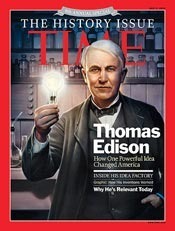 Thomas Edison said … “I’d put my money on the sun and solar energy. What a source of power! I hope we don’t have to wait until oil and coal run out before we tackle that. I wish I had more years left.”
Thomas Edison said … “I’d put my money on the sun and solar energy. What a source of power! I hope we don’t have to wait until oil and coal run out before we tackle that. I wish I had more years left.”Time ® is a registered trademark of Time Inc.
August 23, 2016
Thomas Edison–Still Relevant Today
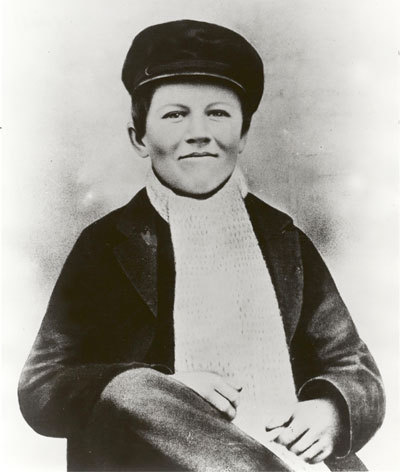
Young Tom Edison-about 12
He is the world’s greatest inventor-proclaimed Man of the Millennium in 1996 by Life magazine. Economists believe because of his incredible lifetime accomplishments, one fourth of all the jobs on the planet today can be traced back to him.
Yes, it is Thomas Edison, the home-schooled boy born in the Midwest in 1847 who develops an indomitable spirit of never giving up and learning from failure.
His early fascination with telegraphy leads to many new inventions including vastly improved telegraphy, a more practical telephone, the stock ticker, and an electric pen-the harbinger of copying machines.
As he matures he rocks the world with the electric light bulb/and the demonstration of the central electric power generation system, the phonograph and movies… three mainstays of our modern world. Another major innovation is the “invention factory”, a system for producing rapid prototypes of new inventions, later to be re-named the R&D lab-arguably his greatest contribution to economic growth.

The Invention Factory
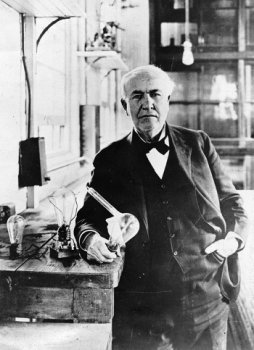
Edison with the First Electronic Patent-a Hybrid Light Bulb Prototype Vacuum Tube
Today, his inventions and accomplishments make up about 10% of the annual American economy…85 years after his death!
On and on the litany of his inventions go-the first electronic patent, leading to vacuum tubes; radio transmission; alkaline storage batteries; loudspeakers; improved cement; fluoroscopy; talking dolls; fluorescent lights. It is a rich and powerful engine of innovation he fashions.
We think it is cool today to have electric vehicles in our garages, charging up overnight. We can thank Edison for this as well, for he pioneered such a thing in 1905-1908. Edison, the visionary, was busy years ago changing our world in yet another way. Oh yes, Edison was a big solar energy enthusiast way back in 1910!
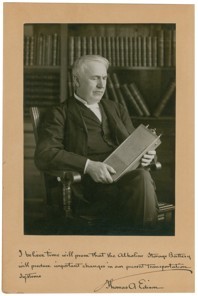
Edison Holding his Famous Nickel-Iron Storage Battery for Electric Vehicles
At his legendary West Orange, NJ labs, known today as the Thomas Edison National Historical Park [NPS], visitors can experience Edison in many displays; and listen to experts discuss the man’s successes and failures.
The Park is the site of the world’s most complete technological museum, the mother ship of our nation’s technological glory, where everything Edison is carefully and lovingly cared for so generations of Americans can experience the birth of our technological prowess. All his original inventions and related 5 million written documents and laboratory notebooks are all there.
About 40,00 students and teachers a year visit the site as part of their STEM classroom experience … for Thomas Edison and what he did at West Orange is the very taproot of STEM learning.

Young Students Visiting the Park and Taking their Junior Ranger Oath
 Thomas Edison said, “I have more respect for the fellow with a single idea who gets there than for the fellow with a thousand ideas who does nothing.”
Thomas Edison said, “I have more respect for the fellow with a single idea who gets there than for the fellow with a thousand ideas who does nothing.”Time® is a registered trademark of Time Inc.
August 4, 2016
Thomas Edison, Concrete, and Clean Air
What say we clear the air … specifically of carbon dioxide, that nasty greenhouse gas pollutant; and when we do, we make a useful product as well … concrete.
An enterprising company, Blue Planet, is unleashing some really cool technology involving biomineralization, the process by which coral reefs and shellfish use carbon dioxide to make their mineral shells. It’s the same process that an oyster employs to make a pearl. One could opine it’s a “gem” of a process.
Quick refresher:
Conventional cement–Portland cement–is made primarily of calcium oxide; but at Blue Planet, their aim is to make a different kind of cement made primarily of calcium carbonate. Cement is the binder that makes concrete–which also contains aggregate, sand and water. About 5-7% of the planet’s greenhouse gas emissions comes from the making of concrete.
The Blue Planet process can feed off a nearby source of carbon dioxide like a natural gas-fired power plant and convert the carbon dioxide into calcium carbonate [limestone], at the rate of a ton of material every two hours. A pilot plant capable of producing 10,000 tons of material a year is being planned. Blue Planet hopes to clean the air and give conventionally produced concrete a run for its money. Famed actor, Leonardo DiCaprio serves on one of the advisory boards of Blue Planet.

Cement is used in many applications around the globe-man’s ubiquitous building material
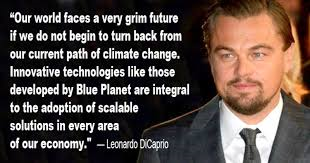
At the University of California, a team is hard at work to also produce concrete using another interesting angle. They start with that pesky carbon dioxide and make a slurry of calcium hydroxide as a feedstock to 3D printers to form beams and other shapes for construction. Since conventional cement making is a great source of carbon dioxide, the U of C effort is aiming at using that carbon dioxide source to make more environmentally clean cement.
The University work is in its early stages, but shows promise. They can ultimately produce usable building shapes in about two hours, compared to waiting 30 days for conventional concrete to fully cure.

J.R. DeShazo, left, and Gaurav Sant show off a sample of the new building material they have created to replace concrete.
It’s worth noting that Mr. Edison revolutionized the traditional concrete-making process at the same time he was creating concrete homes, way back in 1910-1915. He increased the efficiency of cement making. Now, the use of carbon dioxide in the air and in combustion gases is being used to make concrete. I think I see a smile forming on Tom’s face. He was no friend of air pollution as he felt electric vehicles were a much cleaner form of transportation than gasoline vehicles; and he was also a big proponent of solar energy. Were he alive today, Edison would embrace this kind of air cleaning research!
Editor’s Deep Dive:
http://www.blueplanet-ltd.com
https://www.buildinggreen.com/blog/can-man-reinvent-concrete
http://phys.org/news/2016-03-carbon-dioxide-sustainable-concrete.html
 Thomas Edison said, “If we all did the things we are really capable of doing, we would literally astound ourselves.”
Thomas Edison said, “If we all did the things we are really capable of doing, we would literally astound ourselves.”Time ® is a registered trademark of Time Inc.
July 19, 2016
Thomas Edison on Time
Are you one of those people who hear the clock ticking, relentlessly squeezing your productive time? Thomas Edison sure did. He had a keen sense of how fast time was moving; knowing that with each tick of the clock, competition was edging closer.
“The thing with which I lose patience most is the clock. Its hands move too fast”

Edison’s time card would often register 90+ hours a week of work time!
His incredible legacy of team-based invention, which led to the invention factory concept, later to be popularly known as commercial R&D labs, has two great advantages….first, it codifies new product development into a repeatable sequence of steps-thereby extending indefinitely the industrial revolution of the late 1880s, right on up to current times. Second, it allows an incredibly fertile mind like Edison to multiplex his interests and skills across many project teams-which in Edison’s case usually kept 30-40 teams continuously busy with new inventions. In a way, the invention factory was a way to cheat that relentless clock he heard so clearly.
“The only time I become discouraged is when I think of all the things I like to do and the little time I have in which to do them”
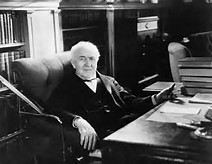
Even in his home library, the mind of the great inventor was ever engaged.
Edison embodied this preoccupation with time with a stretch goal for his teams-often challenging them to come up with a minor invention every ten days and a major one every 3-6 months. Every night in the quiet of his home library, Edison would develop new ideas to be prototyped in his labs. His children would help him find important information from his many technical books, looking through the books and placing bits of paper where Papa could find what he was looking for.
“I would like to live about three hundred years. I think I have ideas enough to keep me busy that long.”
The world is grateful for the relentless work of Thomas Edison, for he defined our modern world, adding incredible value and benefits for generations to come. We should all be glad he heard that ticking clock.
 Thomas Edison said … “Many of life’s failures are people who did not realize how close they were to success when they gave up.”
Thomas Edison said … “Many of life’s failures are people who did not realize how close they were to success when they gave up.”Time ® is a registered trademark of Time Inc.
June 28, 2016
Thomas Edison Admires Li-Fi Lightbulb
I can see ol’ Tom Edison smiling at this next generation lightbulb, a kind of coy smile that might say he’s not that surprised. After all, his original light bulb technology gave birth to vacuum tubes and made radio and TV possible, so why not use that technology for other things.
Today we use Wi-Fi to access [radio waves] and download all sorts of information; but the amount of electromagnetic spectrum devoted to this is quite narrow … sort of like driving down a crowded one-lane road, when what we need is an eight -lane super highway. Light waves are another thing altogether, holding the promise of that super highway. Light waves can easily carry 10,000 times more volume than the currently allocated radio wave spectrum.
When properly equipped, an LED lightbulb can move information and lots of it via light. The key is imbedding a signal processor into the LEDs. Very short LED flashes of light do the data transmission. You don’t even see the flash and it does not affect the bulb’s light quality.

In development since the early 2000’s, Li-Fi technology puts the upper speed for data transmission at 100 gigabits per second, about 15 times faster than the fastest Wi-Fi; and the Li-Fi is more secure too as the download does not pass through walls where it could be intercepted.
With Li-Fi, every LED light bulb can become an ultrafast wireless router or hotspot in the home or office. All your smart appliances can also be data-nourished from your LEDs as well. It’s another dimension of what we call the Internet of Things. Check out the videos embedded in the Editor’s Deep Dive section below-way cool to see and imagine the potential of this technology.

Harald Haas, who teaches at the University of Edinburgh in Scotland, coined the term “Li-Fi” at his TED Global Talk where he introduced the idea of “Wireless data from every light”. He is Chairman of Mobile Communications at the University of Edinburgh and co-founder of pureLiFi. In October 2011, companies and industry groups formed the Li-Fi Consortium to promote and foster the advancement and implementation of this exciting technology. Russian, Chinese and Mexican interests are now active in this technology as well. Standards-making activities are also kicking in. The stage is set for some very interesting applications and large scale demos.
So what do you think, Tom!
Editor’s Deep Dive
http://www.ibtimes.com/what-li-fi-meet-revolutionary-wireless-technology-100-times-faster-wi-fi-2199883
http://www.ted.com/talks/harald_haas_wireless_data_from_every_light_bulb
https://www.youtube.com/watch?v=iHWIZsIBj3Q
 Thomas Edison said, “If we all did the things we are really capable of doing, we would literally astound ourselves …”
Thomas Edison said, “If we all did the things we are really capable of doing, we would literally astound ourselves …”Time ® is a registered trademark of Time Inc.
June 1, 2016
Thomas Edison–Baseball Fan
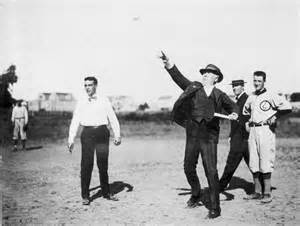 Yes he was, a baseball fan. No big surprise here that he would love this beloved American sport. Here he is below throwing out a baseball, kicking off a long-ago match between teams … boys on a summer day.
Yes he was, a baseball fan. No big surprise here that he would love this beloved American sport. Here he is below throwing out a baseball, kicking off a long-ago match between teams … boys on a summer day.
At his legendary West Orange Labs, with his many employees, probably 10,000 or more, it was only natural for many healthy young men to engage in sports, what would later become known as industrial leagues. Tom supported his different sports teams. Here in the photo below, he is surrounded by one of those baseball teams, circa 1920s.
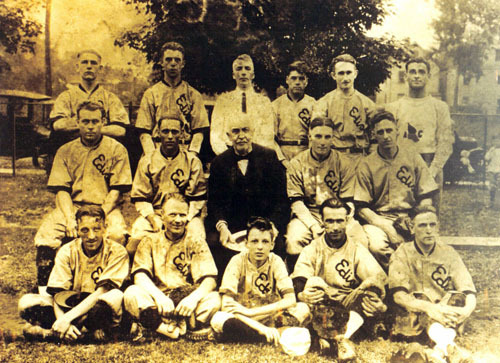
Down at his winter home in Ft. Myers Florida, Edison enjoyed watching the boys tune-up their Spring training for the up-coming season. His attraction to the Philadelphia Athletics [later to become the Kansas City Athletics and later the Oakland A’s] was enshrined in this circa 1925 photo of Tom with (l. to r.) Ty Cobb and Connie Mack. He befriended legendary team manager Connie Mack, often socializing with him and other members of the team, and even occasionally hosting them at his estate. Edison remained a loyal fan, attending Athletics’ spring training and regular season games.
![Connie Mack-TAE-Ty Cobb [best]](https://i.gr-assets.com/images/S/compressed.photo.goodreads.com/hostedimages/1465037398i/19305999.jpg)
There was another fascinating connection Edison had with baseball. His Portland Cement (about 68,000 bags of it) was used to build the world’s most iconic ballpark-Yankee Stadium.
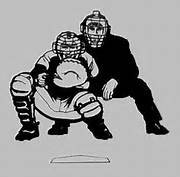
Play Ball!
Check these sites out:
http://edison.rutgers.edu/baseball.htm
http://www.edisonmuckers.org/the-hous...
 “I find out what the world needs. Then I go ahead and try to invent it.”
“I find out what the world needs. Then I go ahead and try to invent it.”Time® is a registered trademark of Time Inc.
May 23, 2016
Edison – Premier Job Creator

Edison in his beloved chemistry lab
In today’s highly charged political environment, folks like to talk about creating jobs and who is best able to do this. Thomas Edison moved to West Orange, NJ in 1886, to live and create what would become his great invention and manufacturing facility-his legendary West Orange Labs. Nothing but farmland in 1887 when construction begins, by 1905, there are over 14,000 people working there-with a full complement of buildings on 25 acres of land.
Here is the real magic of Edison, who teaches the world a powerful economic lesson-the incredible value of R&D in new product development. By 1905, there are about 250 people working in Edison’s invention factory [photo below], where 30-40 project teams are busy creating and building new products.
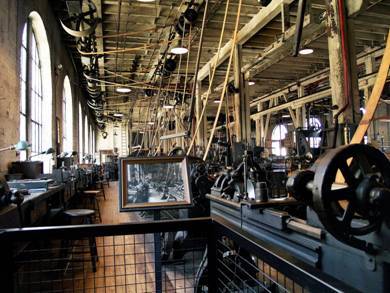
Edison’s heavy machine shop-where invention prototypes take shape
As Edison himself approves these prototypes for production, the other 14,000 employees then make, market, and sell the new products. That is a manpower leverage of almost 60 to 1. An R&D job is capable of creating about 60 more manufacturing jobs. This is the essence of a technology driven economy and what we have generally come to call “progress”. Last year, the U.S. spent almost $500 billion on R&D, across all economic sectors.
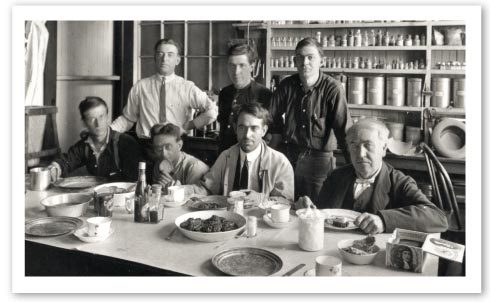
Edison enjoying a meal with fellow inventors, his “Muckers”
In 2012, the Voice of America proclaimed Thomas Edison was probably responsible for one-fourth of all the jobs on the planet. Something he achieved in his labs or patented, or an industry he created, resulted in significant jobs and economies that have come down to us today.
“Among life’s many conveniences we can take for granted, thanks in part to him [Edison]: copiers, radio, movies, TV, phones (he improved Bell’s).” –Life Magazine
Following this up, the Edison Innovation Foundation commissioned in 2015 its own economic analysis of Edison’s impact on our economy. Examining the productivity ripple effect of Edison’s major accomplishments, approximately 10% of the annual national economy, about $1.6 trillion, is directly attributable to the great inventor’s work. At an international level, this translates to about $6-7 trillion per year.
The best way to sum up Edison’s impact is to quote Life Magazine, which proclaimed Edison the “Man of the Millennium!”
 Thomas Edison said, “If we all did the things we are really capable of doing, we would literally astound ourselves …”
Thomas Edison said, “If we all did the things we are really capable of doing, we would literally astound ourselves …”Time ® is a registered trademark of Time Inc.
May 9, 2016
Edison Smiles on his 6th Annual Invention Contest
The Thomas Edison Invention Contest is all about having young folks learn how to integrate alternate energy concepts into problem solving. Back in 1910 Edison was championing the use of solar energy as a clean form of energy. As usual, the great inventor was way ahead of the curve. As you read below, both elementary and high school contestants came up with some creative solutions for the 2016 contest whose theme was …. “use alternative energy to create an invention for a population that had experienced a natural disaster”.
In the Elementary & Middle School Category
1st Place–Freehold Intermediate School: STEM STARZ
New Jersey
STEM STARZ justified using the “power of 3” to aid in disaster relief missions focusing on solar, wind and hydro energy.

2nd Place–Linwood Middle School: STEMINISTS
New Jersey
The team created a device that would send an alarm to an underprivileged or over populated area that is accustomed to floods or earthquakes.
3rd Place–Heritage Middle School: Swagmasters Tech
New Jersey
Project was called “Turbo Turbine” which aids in flood disasters. The team designed these turbines to be placed in sewers so during floods, the running water would still transfer energy to affected areas.
—–
In the High School Category
1st Place–Hackettstown High School: Tiger Team 2
New Jersey
Method for charging aerial drones during flooding situations. The boats would contain various charging stations for the drones to charge while other drones continue dropping supplies such as food and water to flood victims until help can reach their location.

2nd Place–High Point Regional High School: The Composters
New Jersey
Plans to place turbines in sewer systems to generate power during floods.
3rd Place–Chaney Stem Campus: D.R. Responsers
Ohio
Their designs use turbines to generate power for emergency service facilities.
—–
A hearty well-done to all participants, especially the winners. Edison would be smiling at your efforts.
Here are the stats for this year’s contest: 84 student teams comprised of approximately 300 students, from 29 schools scattered over 6 states, competed for honors-and all of the competition was done virtually, with students submitting their work electronically to a panel of judges from the scientific/engineering community.
All student winners have received plaques. First place winning schools have received 3D printers, and second and third place winners will receive prototyping kits for use in the classroom.
 Thomas Edison said … “Many of life’s failures are people who did not realize how close they were to success when they gave up.”
Thomas Edison said … “Many of life’s failures are people who did not realize how close they were to success when they gave up.”Time ® is a registered trademark of Time Inc.
April 13, 2016
Edison Meets the Superheroes–at a Pitch Contest
Eleven students at Draper University’s Hero City met to compete in a high stakes Pitch Contest, sponsored by the Edison Innovation Foundation–the prize-$10,000. Mr. Kenny Hawk, a nationally recognized Silicon Valley entrepreneur, served as co-sponsor and emcee of the event.
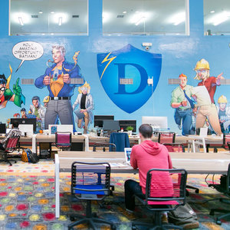
Draper University is a school for innovators, founded by world renowned innovator, Tim Draper. Located in San Mateo, the new entrepreneurial playground between Silicon Valley and San Francisco, Hero City at Draper University is a co-working space that promotes innovation, collaboration, and entrepreneurship.
The students (see photo below) ranged in age from their teens to early 40s, competing with new product ideas and services-having just 2minutes each to present their ideas, with 2 minutes for Q&A. For budding entrepreneurs, pitching ideas is a powerful skill to get potential investors quickly focused on a new idea and willing to learn more about it.
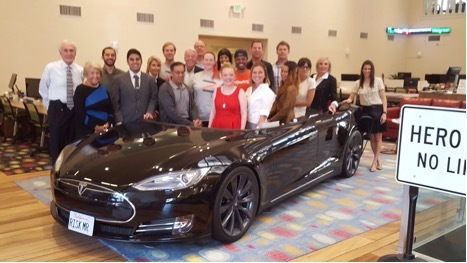
The pitches were quite diverse, ranging from an “on-demand hair salon” to a “hybrid electric conversion kit for auto rickshaws to reduce air pollution and poverty”. The $10,000 winner was Russell Ladson for his entry “using artificial intelligence to contextualize video search”…which basically boils down to using AI software to be able to search video files [like YouTube and others] and be able to find what you want by showing the software an image of what you are looking for.
Shown in the center of the photo below, in bright red shirt, is the winner Russell Ladson. Shown to the right in photo is Mr. John Keegan, President and CEO of the Edison Innovation Foundation.
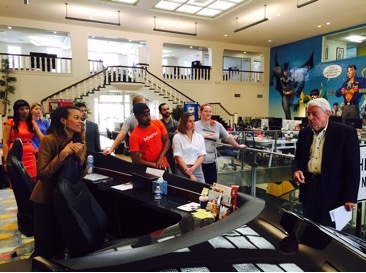
I have got to believe old Tom Edison is smiling over this, young people enthusiastically proposing new ideas and explaining their value. This is exactly what the business world needs and values.
 Thomas Edison said, “If we all did the things we are really capable of doing, we would literally astound ourselves …”
Thomas Edison said, “If we all did the things we are really capable of doing, we would literally astound ourselves …”Harry T. Roman's Blog
- Harry T. Roman's profile
- 2 followers





